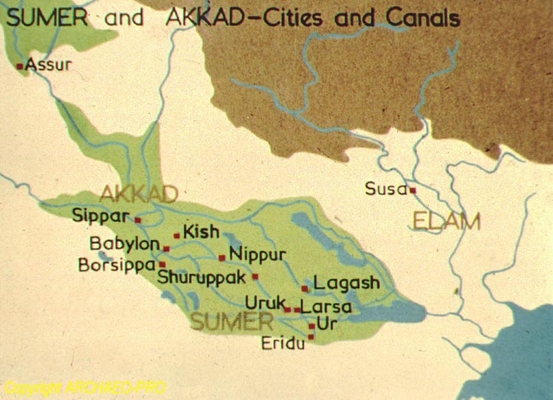 Babylon, Iraq (Mar. 21, 2005) - U.S. Army Soldiers assigned to the 155th Brigade Combat Team (BCT), are given a tour of the historical city of Babylon, Iraq as a gesture of goodwill by the Iraqi people in Babil, Iraq.
Babylon, Iraq (Mar. 21, 2005) - U.S. Army Soldiers assigned to the 155th Brigade Combat Team (BCT), are given a tour of the historical city of Babylon, Iraq as a gesture of goodwill by the Iraqi people in Babil, Iraq.According to Wikipedia (insert grain of salt here), "Babylonia was a civilization in Lower Mesopotamia (central and southern Iraq), with Babylon as its capital. Babylonia emerged when Hammurabi (fl. ca. 1696 – 1654 BC, short chronology) created an empire out of the territories of the former kingdoms of Sumer and Akkad. The Amorites being a Semitic people, Babylonia adopted the written Semitic Akkadian language for official use, and retained the Sumerian language for religious use, which by that time was no longer a spoken language. The Akkadian and Sumerian cultures played a major role in later Babylonian culture, and the region would remain an important cultural center, even under outside rule."
From my last blog entry Androgynous dualities? we know that the pentagram was a symbol in the Sumerian pictogram language for the word "UB," meaning "corner, angle, nook; a small room, cavity, hole; pitfall" that was derived from the orbital patterns of Venus. So it stands to reason that if their next door neighbors the Babylonians adopted the Sumerian language for religious purposes that the pentagram held a similar significance to Babylonian culture as well. We also know that Venus was considered the Sumerians chief goddess, Ishtar/Inanna, in their pantheon of gods and that she was adopted into many post-Sumerian cultures in a similar role as the "Queen of Heaven".
Enter Euhemerus. According to Wikipeida, "Euhemerus (Εὐήμερος, Euhēmeros, meaning happy or prosperous) (working late fourth century B.C.) was a Greek mythographer at the court of Cassander, the king of Macedon. Euhemerus' birthplace is disputed, with Messina in Sicily as the most probable location, while others champion Chios, or Tegea.
He is chiefly known for a rationalizing method of interpretation, known as Euhemerism, that treats mythological accounts as a reflection of actual historical events shaped by retelling and traditional mores."
Euhemerus...in deep thought :)
We have a very interesting theory here put forth by Euhemerus suggesting that the gods of ancient culture may have actually been derived from actual people who were considered cultural heroes to the ancients. I think this theory really helps to put some of the mythologies surrounding these ancient gods into a proper perspective. Leader worship was very common during this time. The Egyptians, for instance, believed that the pharaoh, during life, was an incarnation of Horus and during death became Osiris. This deification of the pharaoh was a convenient way for a leader to gain absolute authority over his or her people. Now back to Babylonian society and their premier queen Semiramis.According to Diodorus Siculous, "The story as given by the most learned of the inhabitants of the region is as follows: Aphrodite (Venus), being offended with this goddess (Derceto), inspired in her a violent passion for a certain handsome youth among her votaries; and Derceto gave herself to the Syrian and bore a daughter (Semiramis), but then, filled with shame of her sinful deed, she killed the youth and exposed the child in a rocky desert region, while as for herself, from shame and grief she threw herself into the lake and was changed as to the form of her body into a fish; and it is for this reason that the Syrians to this day abstain from this animal and honour their fish as gods." From this point on the mythology reads that Semiramis was raised by doves and then slept her way to the top of Babylonian society to eventually marry the King, Ninus, and bear him a child Ninyas. She eventually succeeds the king, who dies, and she becomes the ultimate ruler of Babylon.
http://penelope.uchicago.edu/Thayer/E/Roman/Texts/Diodorus_Siculus/2A*.html#4
Siculous goes on to exclaim about the success of Semiramis' rule in Babylon that is eventually brought to an end by her son Ninyas. Siculous claims that, "some, making a myth of it, say that she (Semiramis) turned into a dove and flew off in the company of many birds which alighted on her dwelling, and this, they say, is the reason why the Assyrians worship the dove as a god, thus deifying Semiramis." I find this aspect of Semiramis and her association with doves very interesting in parallel to the story of Isis from the Egyptians. Plutarch says, "this has been to no small degree the experience of the Egyptians in regard to those animals that are held in honour. In these matters the Greeks are correct in saying and believing that the dove is the sacred bird of Aphroditê (Venus)." Also, in the story of Isis and Osiris, during her search for the body of Osiris in Byblos Isis turned into a dove. So we have a close association of Semiramis with Venus and some parallels with the Egyptian queen Isis and doves.
Now for the fun stuff. What do we get if we combine the goddess mythology, with the down pointing pentagram symbol, and throw in a dash of ritualistic human sacrifice? Why the Congressional Medal of Honor of course!
According to CMOHS.org, the Congressional Medal of Honor Society's website, "In 1965 the Air Force MOH was created and it replaced the Minerva portrait with the head of the Statue of Liberty. Lady liberty has a pointed crown instead of a helmet. And she does stand for liberty although she is derived from the imagery of Semiramis, wife of Nimrod, and Queen of Babylon. Semiramis was famed for her beauty, strength, and wisdom and was said to have built the famous Hanging Gardens of Babylon. She purportedly reigned for 42 years after taking control from Nimrod. She is a mythical figure who might be somewhat based upon a historical figure. "
WAIT A SECOND?! Did I just suggest that the Congressional Medal of Honor relates to ritualistic human sacrifice? According to CMOHS.org, "On December 9, 1861 Iowa Senator James W. Grimes introduced S. No. 82 in the United States Senate, a bill designed to "promote the efficiency of the Navy" by authorizing the production and distribution of "medals of honor". On December 21st the bill was passed, authorizing 200 such medals be produced "which shall be bestowed upon such petty officers, seamen, landsmen and marines as shall distinguish themselves by their gallantry in action and other seamanlike qualities during the present war (Civil War)." President Lincoln signed the bill and the (Navy) Medal of Honor was born."
Ok let's put the pieces of this puzzle together in a logical manner. In the context of Sumerian society human sacrifice was thought of as a form of service to the god-king. The folks unfortunate enough to be serving on the court of the king when the king died were sacrificed in order to continue serving the king in the next life. Today, we have soldiers who get a likeness of the goddess in the shape of an inverted pentagram in honor of risking life and limb in service to the king...errr president. CMOHS.org admits that this medal's original priority was to increase the efficiency of the military rather than honoring brave soldiers.
To add insult to injury (bad pun) let's go to Wikipedia for a quick description. "The Medal of Honor is the highest military decoration awarded by the United States government. It is bestowed on members of the United States armed forces who distinguish themselves "conspicuously by gallantry and intrepidity at the risk of his life above and beyond the call of duty while engaged in an action against an enemy of the United States." Because of the nature of its criteria, the medal is often awarded posthumously." Still don't believe me? Let's take a look at the headquarters for the U.S. Department of Defense...the Pentagon. Below we find yet another derivation of the pentagram. There appears to be a relationship with the U.S. Armed Forces and the pentagram symbol.
http://en.wikipedia.org/wiki/Congressional_medal_of_honor
If you're like me, the symbolism used in the medal of honor and the Pentagon will leave you with a few questions. Are the architects and designers of these symbols aware of the meaning? If so, why use this ancient pagan symbolism in this context? What does this imply about the nature and purpose of war? Is war a modern day version of ritualistic human sacrifice?! More to come...
 J.M. Flagg's 1917 poster, based on the original British Lord Kitchener poster of three years earlier, was used to recruit soldiers for both World War I and World War II.
J.M. Flagg's 1917 poster, based on the original British Lord Kitchener poster of three years earlier, was used to recruit soldiers for both World War I and World War II.






Mythology is oral tradition, and he is correct. These great stories preserve much of a history that has been lost or destroyed, and yet still lives. For example, Hercules represents the city of Herculaeum, and its struggles to survive. Duncan-Enzmann's ice age translations have brought much to light in this area, and the civilization that lived then survived thousands of years and became a great nation, which now has been 'deconstructed.' See article by The Symbologist based on Doc E's work: http://whiteknightstudio.blogspot.com/2016/03/caduceus-vs-asclepius.html
ReplyDelete